Menu
Regimental Sgt. Zippo – In Detail
Elton John’s debut album in the UK, ‘Empty Sky’, was released in 1969. American fans had to wait another year to buy an Elton LP when his eponymous effort was issued. With the release of ‘Regimental Sgt. Zippo’ on Record Store Day 2021, the beginning of Elton’s five-decade-long catalog is backed up by one year.
By John F. Higgins
It was during the intense research phase for last year’s Jewel Box box set Rarities items that the hidden history of Regimental Sgt. Zippo came into focus. In late 1967 and early 1968, the year before Empty Sky was released, twelve songs were recorded and organized onto two LP sides for intended release as Elton’s introduction to the world.
However, it was not to be.
As graphic designer David Larkham recalls, “[Then-manager] Steve Brown would have said to Dick James, ‘Give these guys a little more slack other than just as songwriters in the ‘moon and June’ genre that you’re looking for because they do have other things to say.’ And then a bit later he may have said to Elton and Bernie, ‘Let’s shelve this album and see what you can come up with, and let me produce the next album.’ Which turned out to be Empty Sky.”
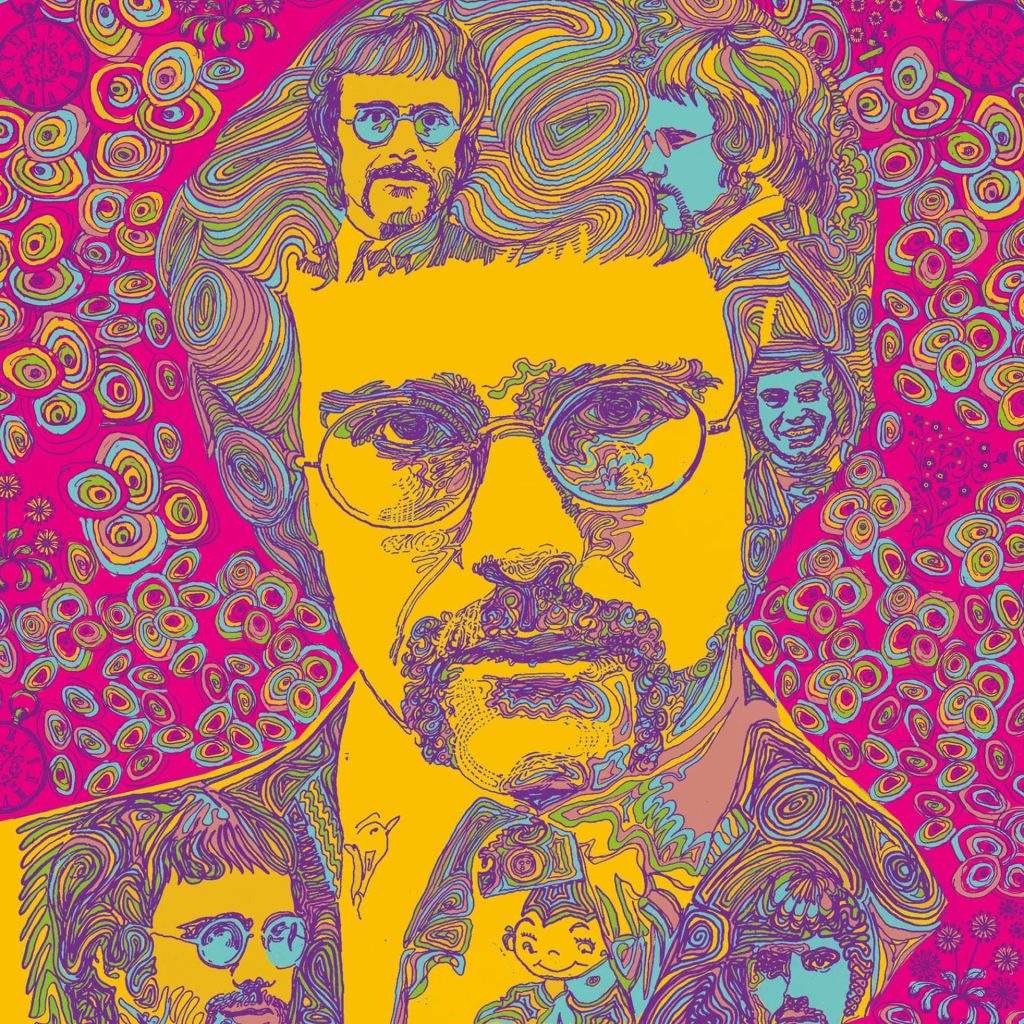
Three of the twelve songs on the unreleased 1968 LP were actually included, in their final version, on Jewel Box last year. The box set also contains eight more RSZ titles, but in the form of early demos or previous incarnations (there is also one alternate mix). The remaining song, You’ll Be Sorry To See Me Go, has its official debut with the Record Store Day drop.
The earliest known activity for a song on Regimental Sgt. Zippo was the recording of the demo for Nina on November 3, 1967, a mere month after the release of Bluesology’s third and final single (Since I Found You Baby) and a full week before Elton and Bernie signed their first publishing deal with Dick James.
On the 15th of that month (so now five days into the songwriting team working on the clock, as opposed to skulking around the 1st-floor studios in the dead of night to capture their steadily growing volume of work before the famed publisher’s staff became wise), Elton, producer/guitarist Caleb Quaye, and the musicians mentioned below picked up their instruments and fired up the four-track tape machine to cut the full-band version of Nina. At some point after, strings were added to the track, and the project was launched. “Regimental Sgt. Zippo was put together as an album, it wasn’t just a pile of demos”, says Larkham.
Elton’s studio work that year was not yet done. In amidst demo-ing and developing a number of other John/Taupin compositions, Elton – or, more accurately, someone at the Dick James office – registered Angel Tree with the UK copyright office on December 13, quite possibly at the very same moment the demo was being recorded. As an intriguing point of reference, Elton sang backing vocals for the Tom Jones hit Delilah the following week. The version of Angel Tree heard on RSZ was recorded on January 11, 1968, with the backing vocals tracked on the 19th, during the same session as the orchestration for Elton’s first single, I’ve Been Loving You, was recorded.
Busy days indeed: in March and April of 1968, he recorded the bulk of RSZ as well as a handful of other new songs, released I’ve Been Loving You, and played his first club performance under his own name on April 30 at the Marquee Club in London. 20 days later, the album’s title track, evoking not only the Beatles’ mind-blowing Sgt. Pepper album but also Elton’s birth name, “Reg”, and the fact that his father was a regimented military man, was tracked and the sessions were complete.
And that is where the story ended…for 53 years. Until now. Finally, “the album that never was”, as Elton calls it, has a home on the Record Store Day shelves and in fans’ collections.
‘Regimental Sgt. Zippo’ album details
All songs written by Elton John and Bernie Taupin, unless otherwise noted.
Recorded on four-track at Dick James Studios, 71-75 New Oxford Street, London, UK.
- Produced by Caleb Quaye
- Engineered by Frank Owen
Musicians:
- Elton John (as Reg Dwight): Piano, Electric Piano, Organ, Harpsichord, Lead and Backing Vocals
- Caleb Quaye: Acoustic and Electric Guitars, Flute, Percussion, Backing Vocals
- Dee Murray: Bass, Backing Vocals
- Dave Hynes: Drums, Backing Vocals
- Paul Fenoulhet Orchestra – arranged by Zack Laurence
When I Was Tealby Abbey
- UK copyright: April 3, 1968
- Recorded: April 5, 1968 (take 7)
- First of two songs recorded during 7 PM session
- Instruments: Piano, organ, guitar, bass, drums, lead vocals, backing vocals, orchestra, flute, timpani, cymbals
- Arranged Band Version [Jewel Box: Piano Demo]
Trivia
There is, in fact, a church in the village of Tealby, which is located just a few miles from Bernie’s childhood home in Market Rasen, Lincolnshire.
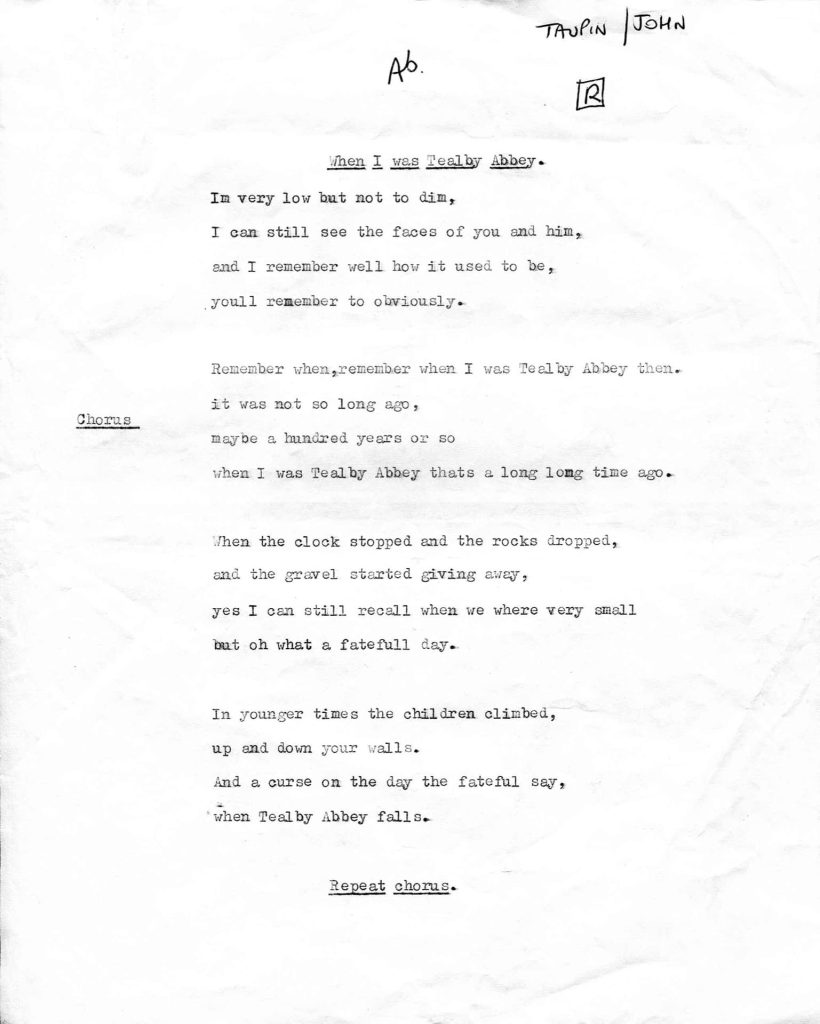
Original lyric sheet (courtesy of John McEwen)
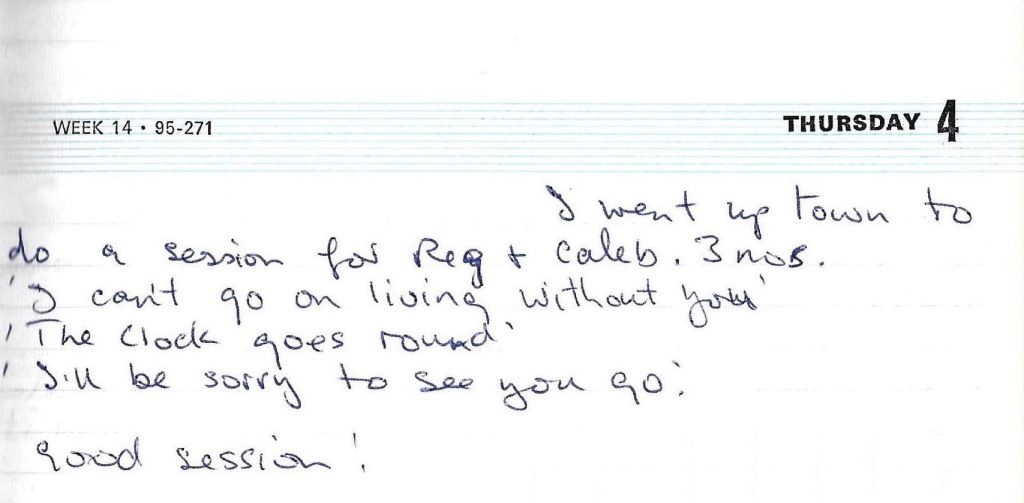
Excerpt from the diary of Dee Murray (courtesy of Anett Murray)
And The Clock Goes Round
- UK copyright: April 3, 1968
- Recorded: April 4, 1968 (take 3)
- Second of three songs recorded
- Instruments: Piano, electric piano, guitars, bass, drums, percussion/clock sound effects, lead vocals, backing vocals
- Band Version [Jewel Box: Piano Demo]
Sitting Doing Nothing
- Writers: Elton John and Caleb Quaye
- Recorded: March 7, 1968 (take 4)
- Second of two songs recorded
- Instruments: Piano, guitar, bass, drums, lead vocals, backing vocals
- Band Version (alternate mix) [Jewel Box: Band Version]
Trivia
In what is perhaps the only such instance in Elton’s entire catalog, Elton wrote the lyrics and Caleb wrote the music for this song.
Turn To Me
- Recorded: March 10, 1968 (take 10)
- Second of four songs recorded
- Instruments: Piano, organ (two tracks), guitar, bass, drums, lead vocals, backing vocals, horns
- Arranged Band Version [same as Jewel Box]
Trivia
This song was covered by Plastic Penny, with band member Nigel Olsson, in 1969…making it one of the earliest connections between Elton and his long-time drummer.
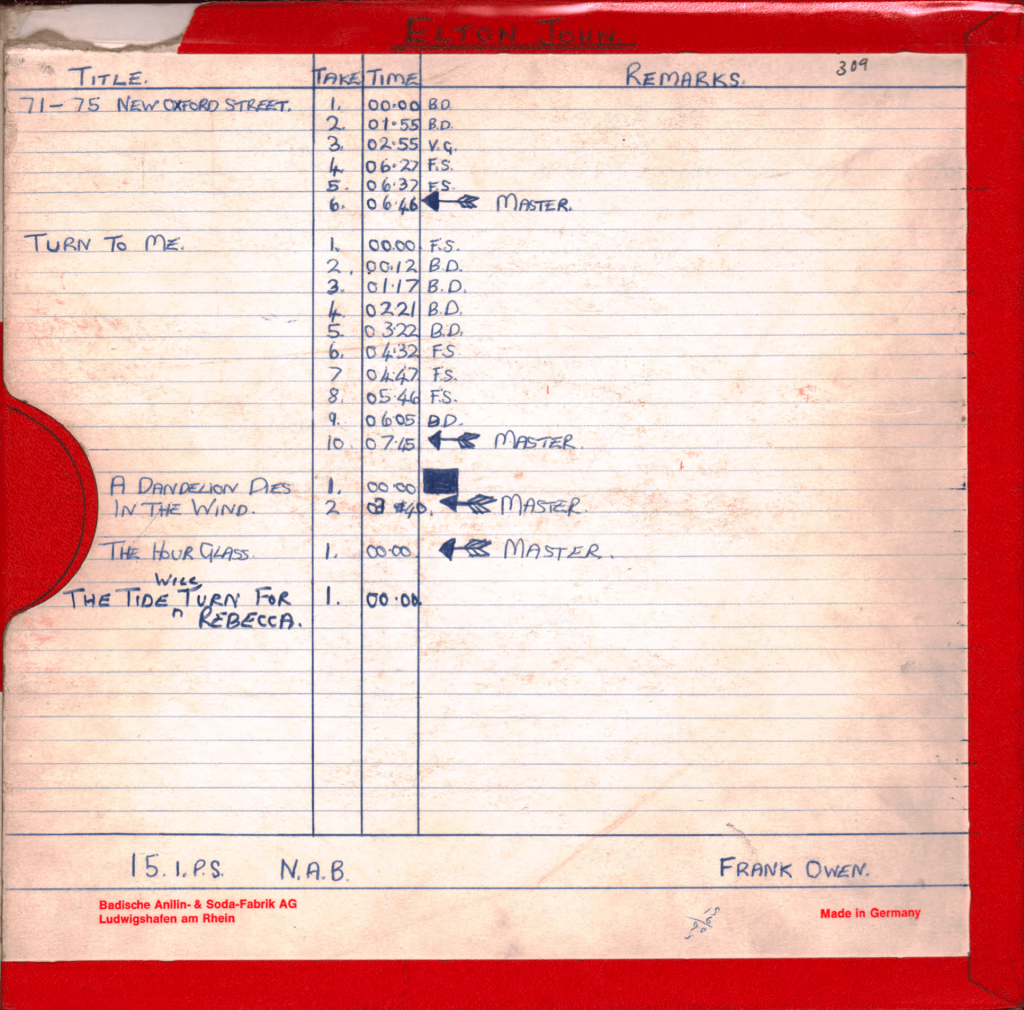
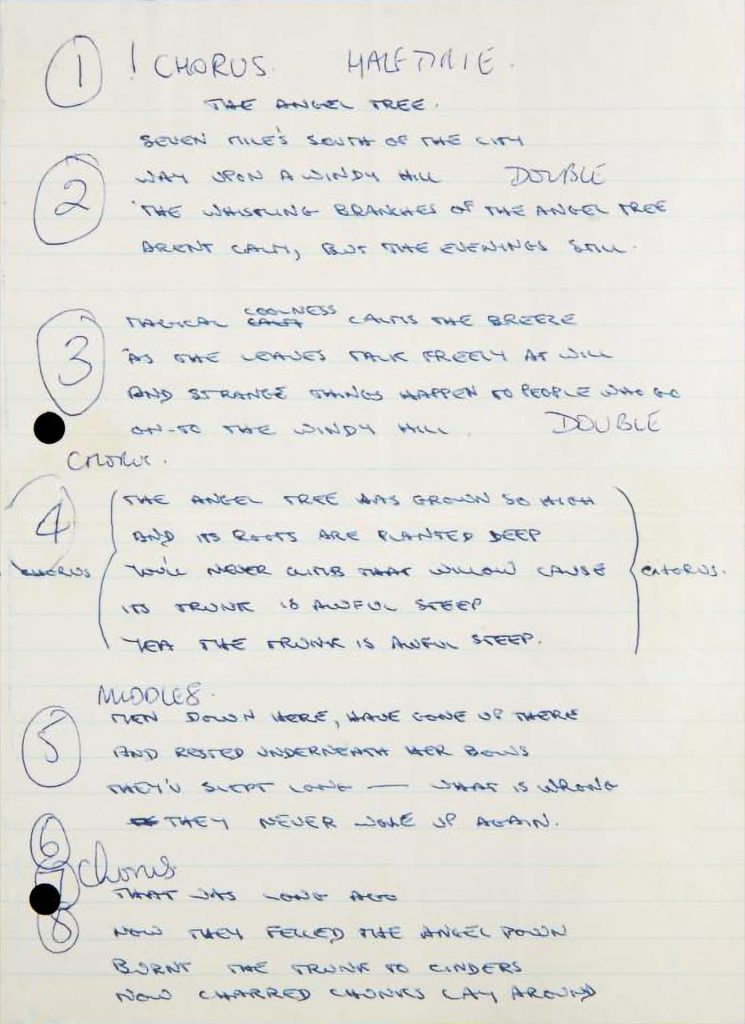
Angel Tree
- UK copyright: December 13, 1967
- Recorded: January 11, 1968 (take 3) / Backing vocals: January 19
- Second of two songs recorded
- Instruments: Piano, organ, guitar, bass, drums, tambourine, lead vocals, backing vocals, horns
- Arranged Band Version [Jewel Box: Piano/Guitar/Tambourine Demo]
Trivia
The lyric refers to a tree in Lincolnshire…the same one referenced in the first line of Burn Down The Mission.
Regimental Sgt. Zippo
- Recorded: May 20, 1968 (take 2)
- Only song recorded that session
- Instruments: Piano, organ, guitar, bass, drums, flute, lead vocals, backing vocals, psychedelic effects
- Complete Band Version [Jewel Box: Band Version]
Trivia
Dee Murray diary entry: “Went up the office to do a session for Caleb + Reg. They had 4 nos. to do, but decided just to concentrate on one. ‘Regimental Sgt. Zippo!’ Turned out fantastic. Especially a gunshot done with one single beat on the floor tom-tom, echoed limited and compressed, ridiculous noise! Started at 7 pm – finished at 2.15 am.”
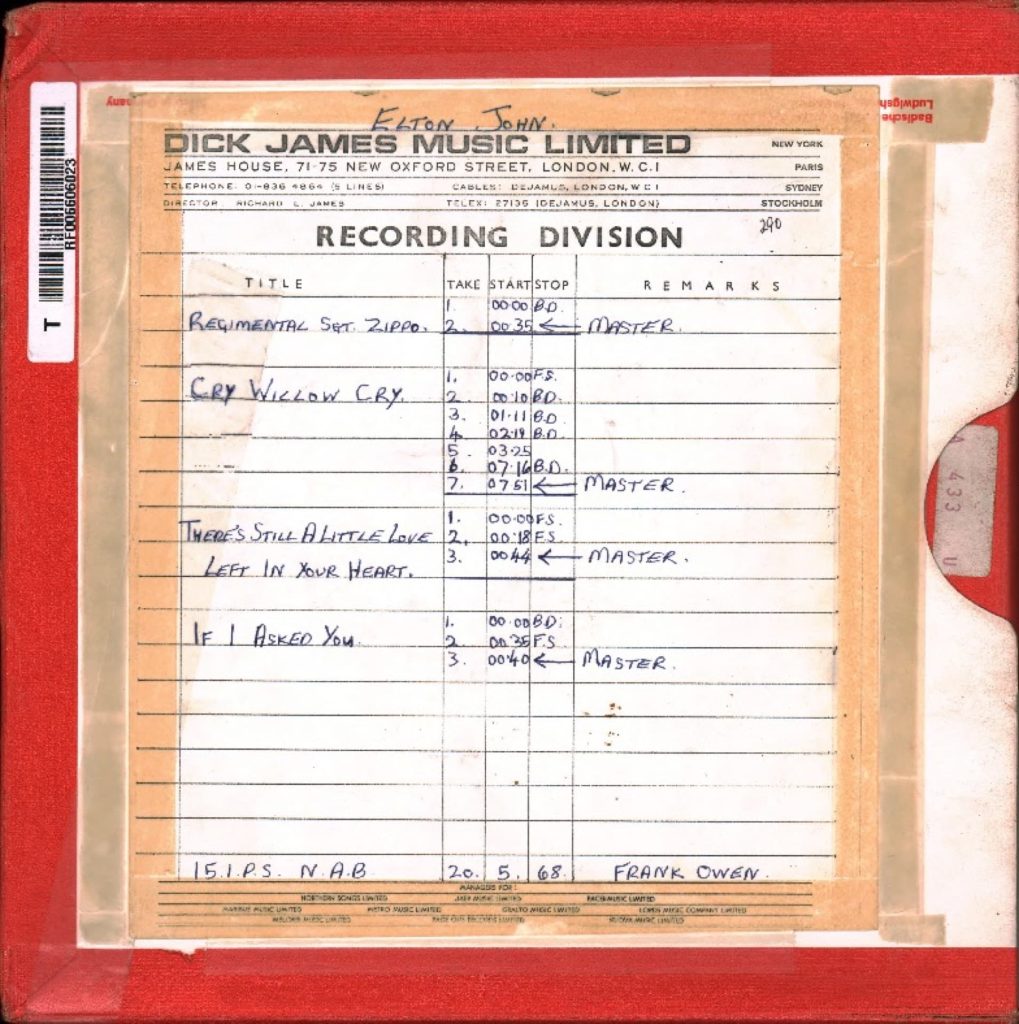
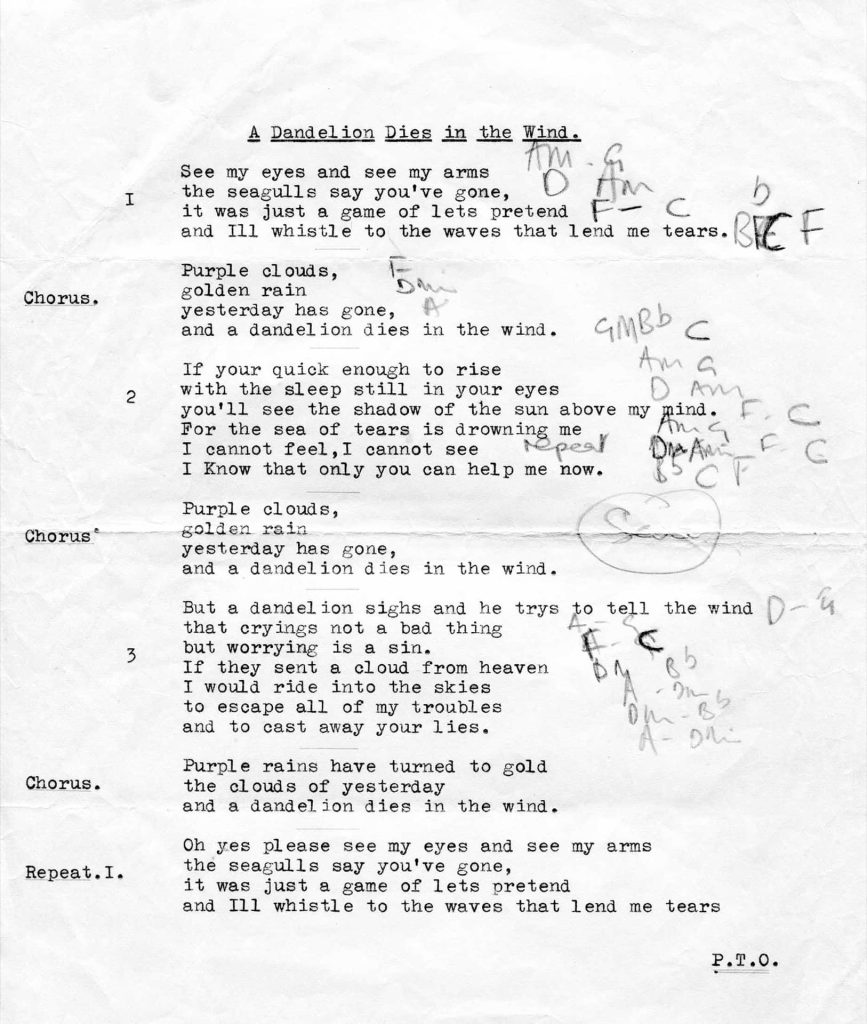
Original lyric sheet (courtesy of John McEwen)
A Dandelion Dies In The Wind
- UK copyright: September 29, 1967
- Recorded: March 10, 1968 (take 2)
- Third of four songs recorded
- Instruments: Piano, organ (two tracks), guitar, bass, drums, lead vocals, backing vocals
- Band Version [Jewel Box: Piano Demo]
You’ll Be Sorry To See Me Go
- Writers: Elton John and Caleb Quaye
- Recorded: April 4, 1968 (take 3)
- Third of three songs recorded
- Instruments: Piano, guitar, bass, drums, tambourine, hand claps, lead vocals, backing vocals
- Band Version
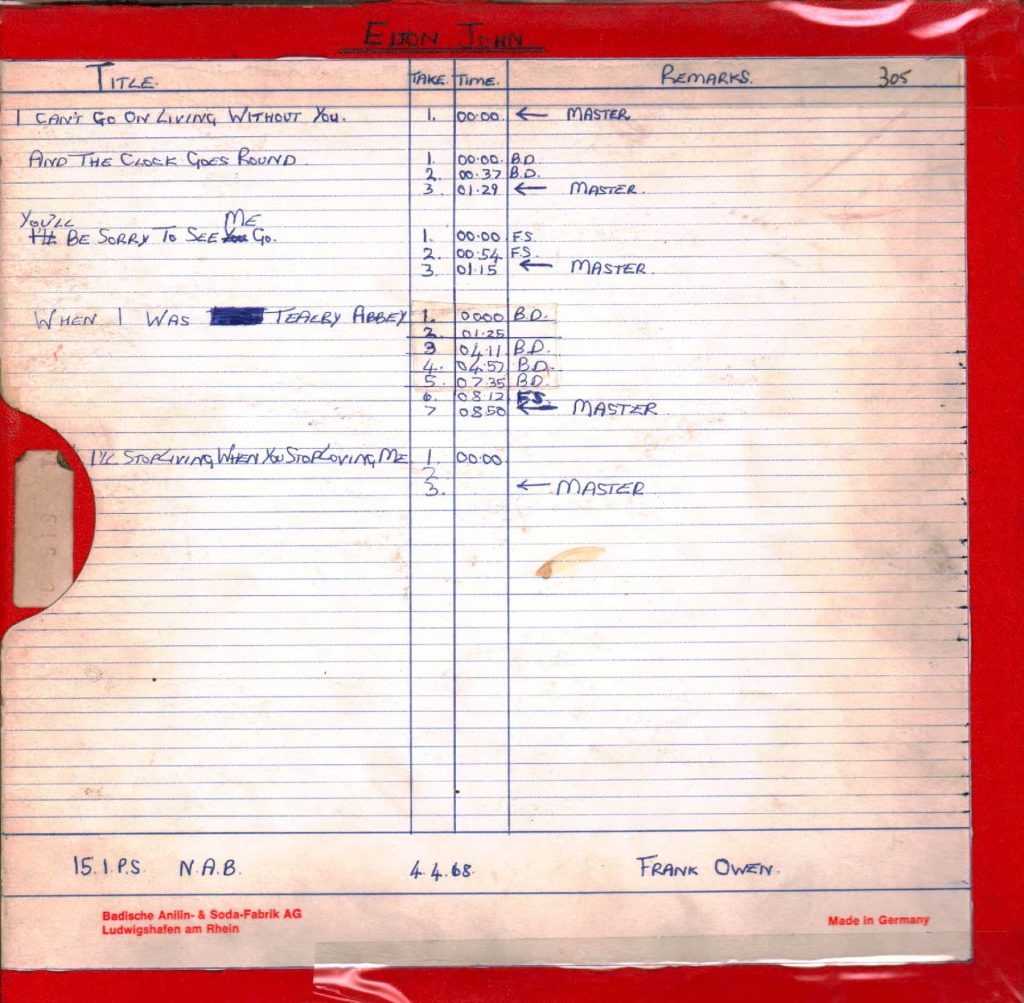
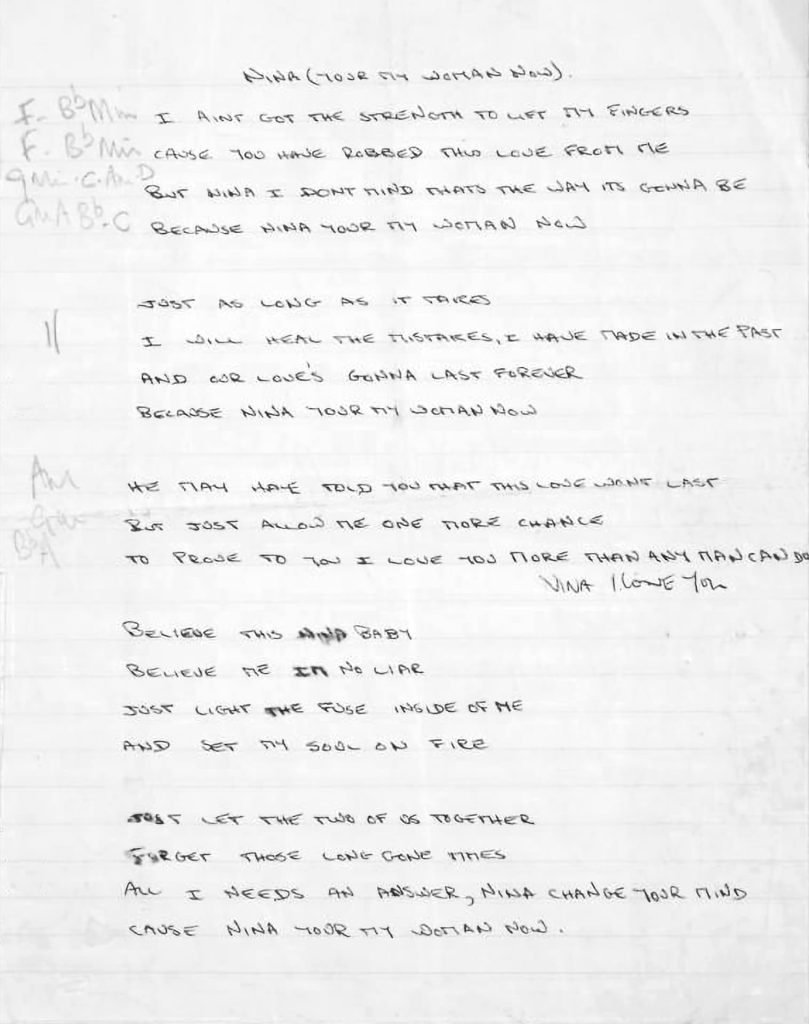
Original lyric sheet (courtesy of Peter Thomas)
Nina
- UK copyright: November 6, 1967
- Recorded: November 15, 1967 (take 7)
- First of two songs recorded
- Instruments: Piano, organ, guitar, bass, drums, lead vocals, orchestra
- Arranged Band Version [Jewel Box: Band Version]
Tartan Coloured Lady
- Recorded: February 16, 1968 (take 11)
- Only song recorded that session
- Instruments: Harpsichord, guitar, bass, drums, flutes, lead vocals, orchestra
- Arranged Band Version [same as Jewel Box]
Trivia
Dee Murray diary entry: “Went up town to do an afternoon session with Reg + Caleb – one number ‘Tartan Coloured Lady‘ harpsichored [sic], jumbo, (drums and bass in M8) Beautiful!”
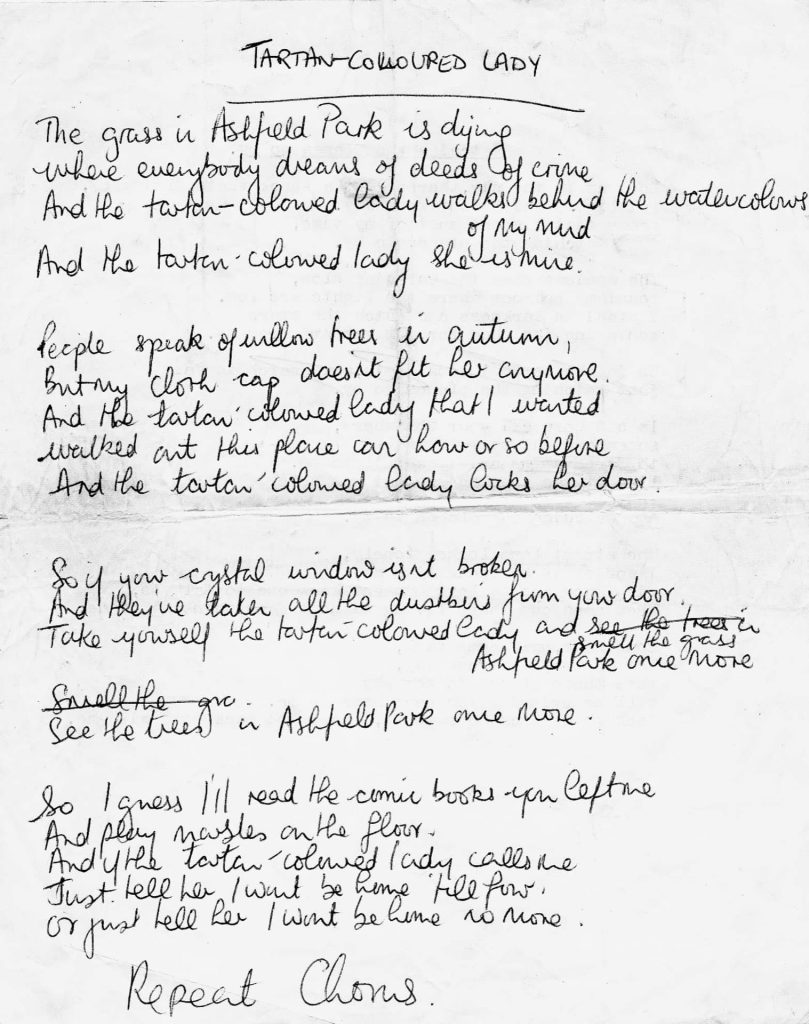
Original lyric sheet (courtesy of Peter Thomas)
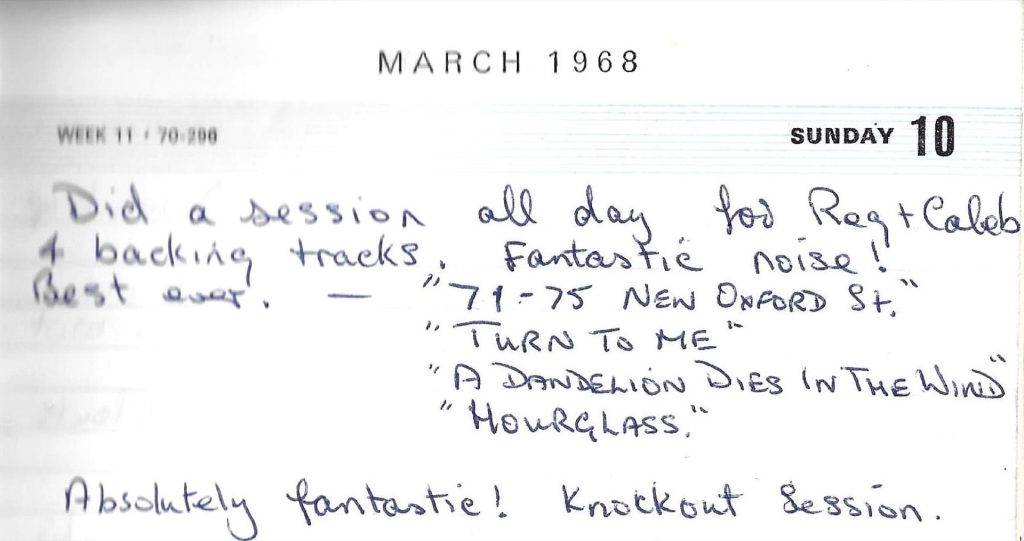
Excerpt from the diary of Dee Murray (courtesy of Anett Murray)
Hourglass
- Recorded: March 10, 1968 (take 1)
- Third of four songs recorded
- Instruments: Piano, electric piano, guitar, bass, drums, lead vocals, backing vocals
- Band Version [same as Jewel Box]
Watching The Planes Go By
- Recorded: February 6, 1968 (take 1)
- Second of two songs recorded
- Instruments: Piano, organ, guitar, bass, drums, lead vocals, backing vocals, orchestra, horns
- Arranged Band Version [Jewel Box: Band Version]
Trivia
This is Caleb Quaye’s favorite song of the “Dick James” era rarities.
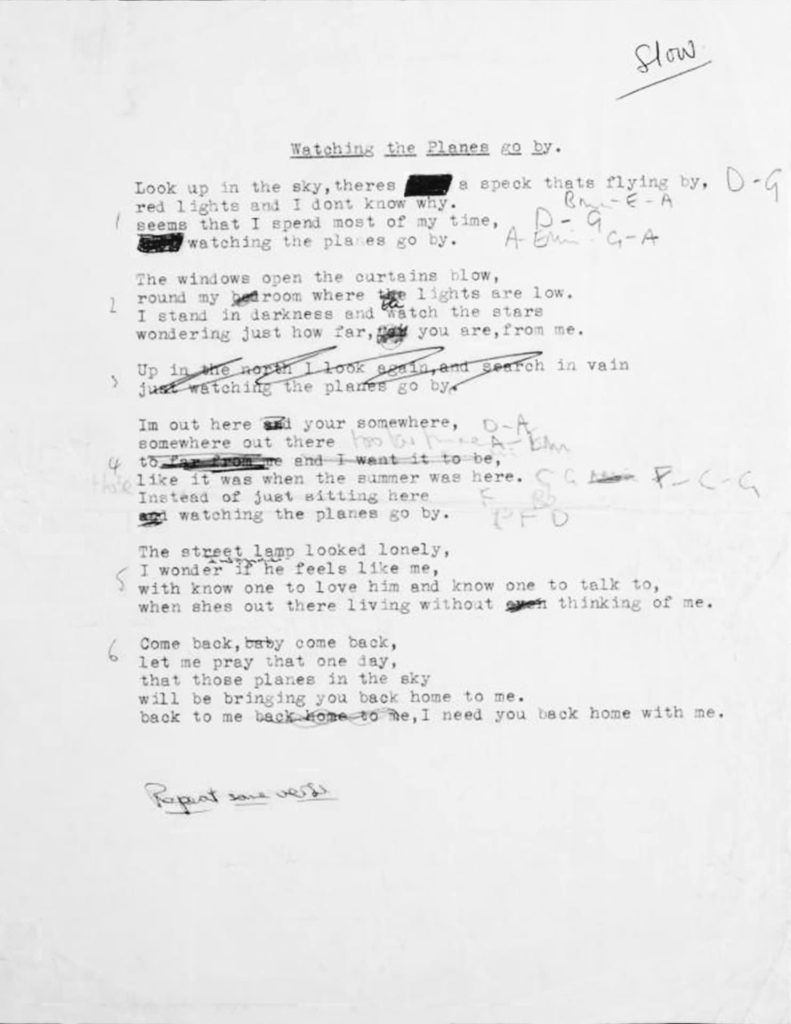
Original lyric sheet (courtesy of Peter Thomas)
Album illustration
The cover art for Regimental Sgt. Zippo was not the original 1968 album design. The LP was shelved well before that part of the production process began; the original album acetate that is in the private collection of Peter Thomas is in a plain sleeve.
In 1969, artist David Larkham was asked by Steve Brown to design something for a press kit to promote Empty Sky and other aspects of the burgeoning artist’s career. He spent “a few nights or a weekend” working around his full-time job with The Evening Standard newspaper to create the pen and ink drawing, based upon a series of black and white photographs that Larkham had taken of Elton the year before. “That was how he looked in 1968, with the horseshoe mustache and Noddy shirt.”
“The illustration was in black and white,” Larkham explained to EltonJohn.com. “Had there been a budget for a four-colour treatment at that time, I am sure that it would have looked kind of like what [designer] Darren Evans did for the Record Store Day release. The swirls and everything around Elton’s head were inspired by famous graphic designer Milton Glaser (he did the iconic Bob Dylan poster), and I put in Bernie’s face [in Elton’s left ear], Elton’s faces, and even a Steve Brown face [on Elton’s left lapel].”
“It was all very of the time (as, indeed, Bernie’s lyrics were for the songs on that album): bright colours and ‘flower-power’. And I feel it still stands the test of time!”
